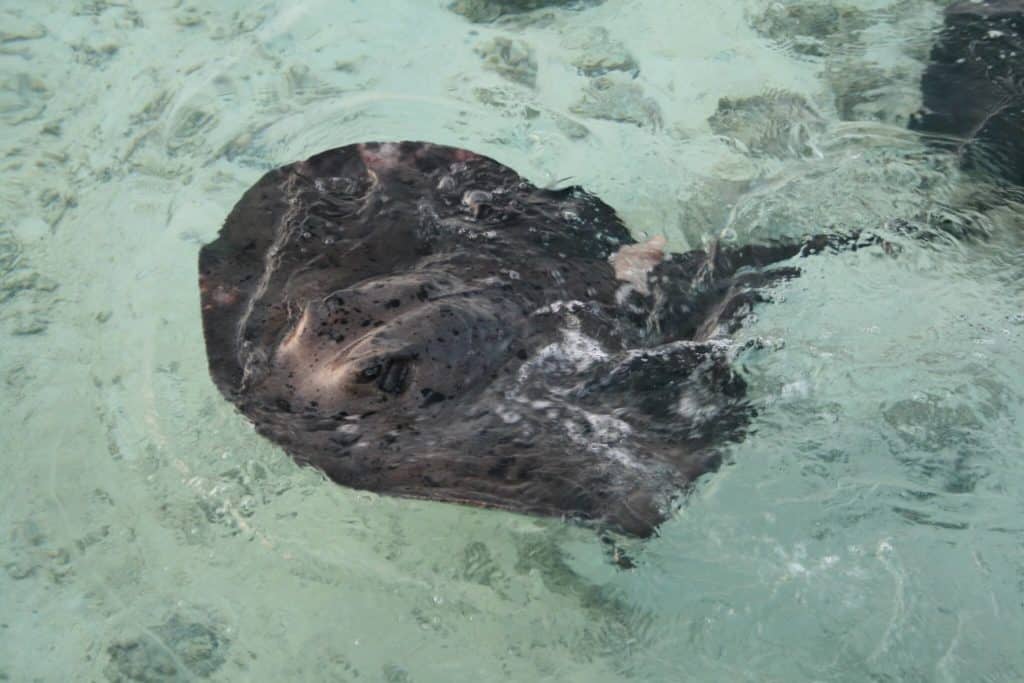Stingrays are some of the most fascinating in our oceans, with around 200 different species inhabiting our oceans they are incredibly common in some parts of the world.
Rays get a bad reputation because of their barbs, but in actual fact, they are generally soft, gentle animals that are shy and avoid confrontation.
In this post, we’re going to take a look at how stingrays give birth, and answer do stingrays lay eggs?
No, stingrays do not lay eggs. They are ovoviviparous which means their young are hatched from eggs that are held in the body, so they give live birth without laying eggs.
Do Stingrays Actually Lay Eggs?
Unlike many species, stingrays do not lay eggs to give birth. Stingrays are ovoviviparous that have young in litters from five to thirteen.
Female stingrays hold the embryos in the womb without a placenta. Instead, the embryos absorb nutrients from a yolk sac.
After the yolk sac is depleted, the mother provides “uterine” milk to help her young survive.
This minimizes risk when it comes to giving birth, and gives her young a much better chance of survival than if she was to lay eggs.
Do Stingrays Give Live Birth?
Most fish species have external fertilization and don’t undertake much parental care, whereas stingray mothers keep their eggs inside their bodies during development.
When the time is right, the stingray mother will give birth to live young. It’s a fascinating process that keeps the young safe whilst growing.
Due to the lifestyle stingrays lead, the pups need to be fully competent swimmers by the time they are born, there is no time for learning the ropes in the wild.
After a few minutes of disorientation, the stingray pups are able to understand which way is up as well as how to swim, and how their muscles work.
This means they don’t need any parental care after they are born and have the best chance of survival.
How Many Babies Do Stingrays Have?
Female stingrays usually reach sexual maturity by the age of one, where they will then begin to look for a mate.
When she finds a suitable mate, the male stingray will follow her and bite her disc, which then enables him to insert his clasper into her cloaca.
For the most part, female stingrays will give birth once a year to around two to six pups at a time, however, sometimes rays can give birth to as many as 13 pups at one time.
Due to the stingrays growing inside of their mothers, when they are born they are already considerable size.
They look like smaller versions of their mothers, with many not able to tell the difference between pup and mother.
Whilst the pups are still inside their mother, they grow to be quite large so that when they are born they are able to swim and essentially fend for themselves.
Once the pups are born, they will generally stay with their mothers until they learn how to hunt effectively.
When they can hunt and fend for themselves, they will leave the safety of their mothers and face life on their own.
How Do Stingrays Mate?
During the breeding season, male stingrays will rely on their ampullae of Lorenzini to sense certain electrical signals given off by females.
When a male finds the right partner, he follows her relentlessly and regularly bites her pectoral disc.
When stingrays mate, a male will impregnate the female by using its modified pelvic fin as he bites the female’s back.
Males use their clasper to transfer their sperm into the female’s oviduct, which then impregnates the female.
Tiny structures at the end of a male’s clasper are responsible for keeping contact inside the female’s cloaca whilst copulating.
When Do Stingrays Give Birth?
Generally, females give birth once a year and can do so in both shallow or deep waters depending on the species.
Round stingrays have an annual reproduction cycle with peaks in mating usually occurring between May – July.
These rays have a gestation period of 3 – 4 months. Most births happen between the months of August – November.
Final Thoughts
So, do stingrays lay eggs? No, unlike many marine animals, they do not lay eggs. Stingrays give birth to pups that are developed inside of their mothers.
When a stingray pup is ready to be born, they are often a decent size and able to swim and get to grips with the ocean very quickly.
They still need to rely on their mothers to be taught how to hunt and find food, but once they learn this they are very much independent.
Stingrays are incredibly diverse, with them often getting a bad wrap due to the defensive barbs that they use to fend off predators.
Despite their undeserving reputation, most stingrays are relatively shy and will avoid human contact. They only usually sting people when stepped on in shallow waters.
Hopefully, you’ve learned something new today in this post, and you now know more about stingrays giving birth and how they do so.
Thanks for taking the time to read this post and feel free to stick around to learn more about stingrays and other marine wildlife.

Hi, I’m George – the founder of MarinePatch. I created this blog as marine wildlife has been my passion for many years. I’ve spent over a decade in the marine wildlife industry and spent years out in the field conducting research. In today’s modern world, an online blog is the best place for me to share my findings and reach as many people as possible to help educate and inspire others. Enjoy your time here and you’re welcome back anytime!

